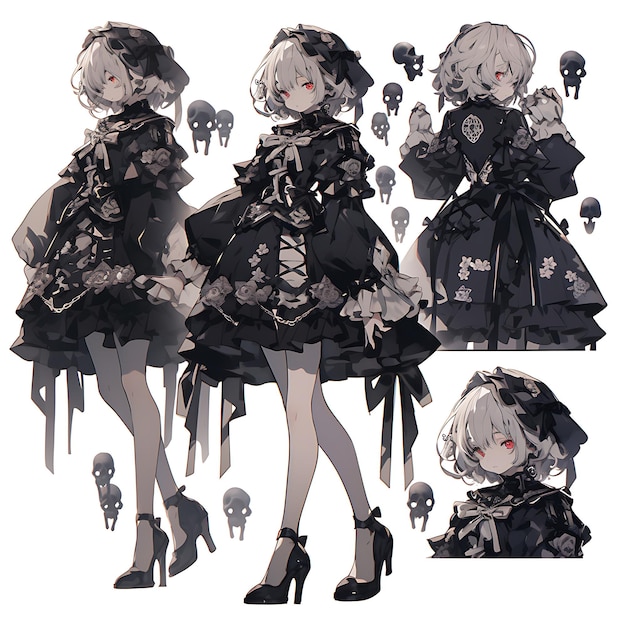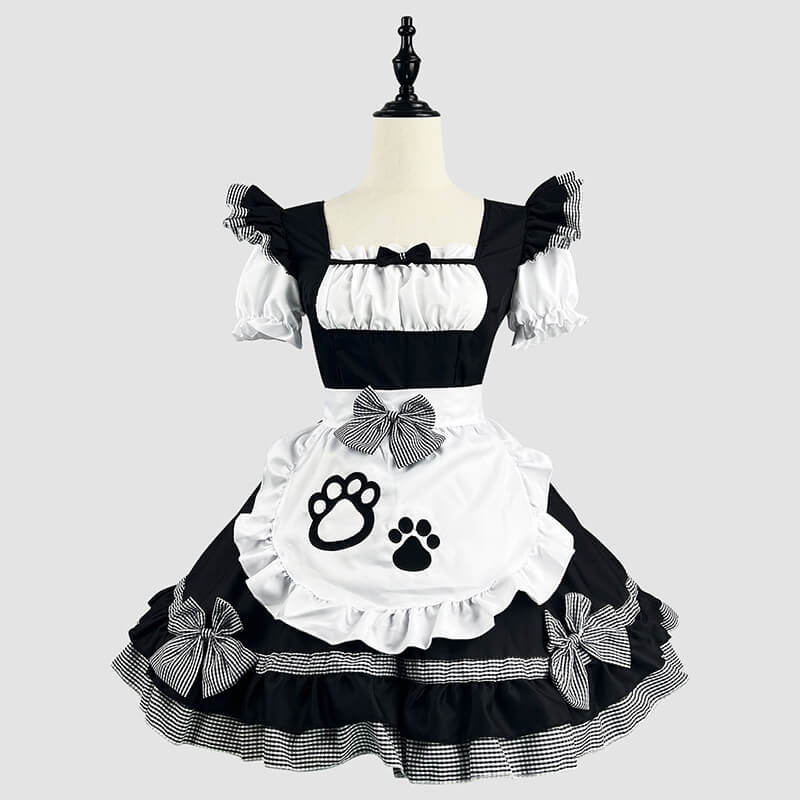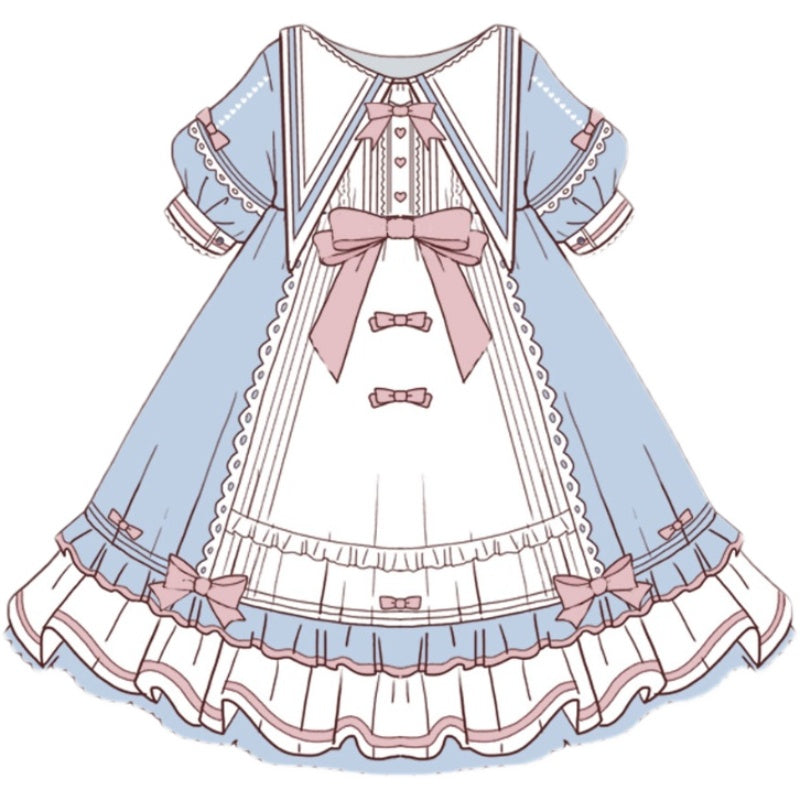Drawing has long been a popular pastime, especially for fashion enthusiasts. One particularly enchanting style is the Lolita dress. This fashion trend emerged in Japan in the 1990s and has steadily gained global popularity. Lolita dress drawing can be captivating, allowing artists to explore intricate designs and elaborate details. In this article, we will delve into the techniques involved in creating stunning Lolita dress sketches, the cultural significance of this fashion, and practical tips for aspiring artists.
Understanding Lolita Fashion
Lolita fashion is not merely a trend; it is a lifestyle that embodies a unique aesthetic. This fashion is heavily inspired by Victorian and Rococo styles. The garments are characterized by their modesty, elaborate patterns, and elegance. To understand how to draw these dresses, one must first grasp their cultural roots and significance.
The Historical Roots of Lolita Fashion
Lolita fashion draws inspiration from historical periods. Designers imbue their collections with elements from the Victorian and Rococo eras. In these periods, clothing emphasized intricate details and elaborate skirts. As a result, the dresses often feature petticoats, lace, and frills.
Moreover, these historical elements hold deep cultural significance. They symbolize a fusion of innocence and sophistication. As you begin your drawing journey, understanding these historical nuances will enhance your portraits.
Key Characteristics of Lolita Dresses
Lolita dresses typically have distinct silhouettes. They often include an A-line shape, which flatters various body types. Additionally, many pieces are adorned with lace, ribbons, and bows. These embellishments elevate the garment’s overall charm further.
Another key characteristic is the color palette. Pastel and vibrant hues are popular choices. However, dark colors are equally attractive in certain styles. Thus, diversity in colors allows artists freedom in self-expression while creating their draws.

Techniques for Drawing Lolita Dresses
Having a solid foundation in drawing techniques can set you up for success. Techniques such as sketching, shading, and adding details will bring your designs to life. Mastering these skills will significantly improve your ability to draw accurate and elegant Lolita dresses.
Starting with Basic Sketches
To begin with, start by sketching basic shapes. Create the general silhouette of the dress first. Use light pencil strokes to outline the dress’s shape. Focus on proportions and angles, ensuring they appear natural.
Once satisfied with the basic shapes, begin adding details. This includes the neckline, sleeves, and skirt length. At this stage, pay attention to the structure of the dress. Proper proportions will enhance the overall appearance of your lolita dress drawing.
Incorporating Details and Textures
After sketching the basic outlines, focus on adding embellishments. Features such as lace trim and decorative buttons add depth. Use varying line weights to create a sense of texture. Thicker lines convey sturdiness, while thinner lines convey delicacy.
Shading is also crucial in this stage. Use light and dark tones to highlight certain areas. Proper shading can transform a flat drawing into something three-dimensional. Experiment with shading techniques, such as hatching and cross-hatching, to find what works best for you.
Designing Your Own Lolita Dress
For those interested in creating their own Lolita dresses, understanding the principles is crucial. Whether starting from scratch or customizing existing pieces, an eager mind goes a long way. In this section, we will explore the initial steps and resources needed for this creative process.
Elements to Consider
Before diving into the design process, several elements require careful consideration. First, identify your preferred style within the Lolita subgenres, such as Gothic, Classic, or Sweet. Each has distinct aesthetics, guiding fabric and color choices. Moreover, consider the occasion for which the dress will be worn. This determines the level of formality, length, and embellishments, significantly affecting overall design.
Additionally, take your personal preferences and body shape into account. Understanding your body type allows for strategic choices in silhouette and length, ensuring a flattering fit. Seek inspiration from various sources, such as fashion blogs, magazines, or social media accounts. This helps to broaden your perspective, guiding you towards unique design elements that resonate.
Tools and Materials Needed
Once you have a clear vision, gather the necessary tools and materials. Basic sewing supplies, including scissors, pins, and a sewing machine, are fundamental. Depending on your sewing prowess, a beginner-friendly sewing machine can be invaluable.
Next, choose your fabrics with care. As previously mentioned, cotton, lace, and chiffon are popular choices. However, consider your functional and aesthetic needs as you select colors and textures. Additionally, think about any embellishments you’d like to incorporate, such as ribbons or lace trims. These elements not only enhance visual appeal but also elevate your creation’s uniqueness.
Patterns and Techniques
When it comes to constructing your dress, you have a choice between using existing patterns or creating your own. Many commercial patterns cater specifically to the Lolita aesthetic, providing clear guidance. Alternatively, for a more personalized approach, drafting your pattern can be rewarding. Online tutorials and sewing communities offer valuable resources for aspiring designers. Here, you will learn different sewing techniques to master the required skills.
While sewing, meticulous attention to detail will yield impressive strides. Pressing seams, finishing edges, and keeping accurate measurements contributes to achieving professional results. Remember that practice is key; the more you sew, the better you become. Embrace any mistakes as learning opportunities as part of the creative journey.

The Cultural Impact of Lolita Fashion
Lolita fashion has transcended mere clothing; it holds substantial cultural significance. The style often evokes themes of youth, innocence, and femininity. As such, many wearers appreciate this fashion for its ability to express individuality.
The Appeal to Individuality
For many enthusiasts, Lolita fashion embodies personal expression. Wearing these unique garments often serves as a rebellion against mainstream trends. This allows individuals to showcase their creativity in an idyllic, almost whimsical manner.
Furthermore, the distinctiveness of each outfit makes every dress a canvas for artistic expression. This vibrant individuality has fostered a community centered around admiration for the style. As you draw, contemplate the unique expressions portrayed in each piece.
The Globalization of Lolita Fashion
Over the years, Lolita fashion has garnered a global audience. Although it originated in Japan, it has spread to various countries. This globalization allows for diverse interpretations of the style, enriching the community.
Different cultures adapt Lolita elements to suit their regional aesthetics. This blending creates novel designs while keeping the essence intact. As an artist, feel encouraged to reflect this diversity in your drawings. Incorporate elements from different cultures to enrich your designs.
Tips for Aspiring Artists
To further hone your skills in lolita dress drawing, consider some practical tips. These strategies can help you improve not only your technical abilities but your understanding of the fashion itself.
Practicing Regularly
One of the most effective ways to improve your drawing skills is through regular practice. Set aside dedicated time each week for sketching. This will enable you to develop a consistent style and refine your techniques.
Not every drawing needs to be a masterpiece. The key is to enjoy the process, embracing both successes and failures. Assess your sketches critically, understanding what works and where you could improve.
Seeking Inspiration
Inspiration can often act as a catalyst for creativity. Look at various fashion magazines, online platforms, or even community events for ideas. Artists can benefit substantially from visual stimuli, igniting imagination.
Social media platforms allow you to connect with other enthusiasts. Engage with their work to learn new techniques. This networking can also provide constructive feedback, which is invaluable for growth.

Conclusion
Lolita fashion remains an iconic and enchanting art form. Its rich history and complex themes create an engaging narrative. We explored key features, craftsmanship, and cultural influences, emphasizing the importance of context. Designing your own dress allows for creativity and personalization, ensuring your style resonates with your identity.
As we look to the future, possibilities continue to unfold. Emerging trends and a robust community promise to enrich the fashion further. Regardless of the direction, the resilience of Lolita fashion showcases its ability to adapt. Ultimately, it is not just about clothing; it is about self-expression, creativity, and empowerment. In this vibrant world, the Lolita dress will always have a cherished place.
Lolita dress drawing is more than just an artistic endeavor; it celebrates a vibrant culture and rich history. Understanding the roots of this fashion can significantly enhance your artistic expression. Moreover, by mastering various drawing techniques, you can breathe life into your sketches.
While the journey may come with challenges, the rewards of creating beautiful designs make it worthwhile. Embrace both individuality and cultural diversity in your work. Finally, remember that improvement comes with time, practice, and exploration. Happy drawing!


